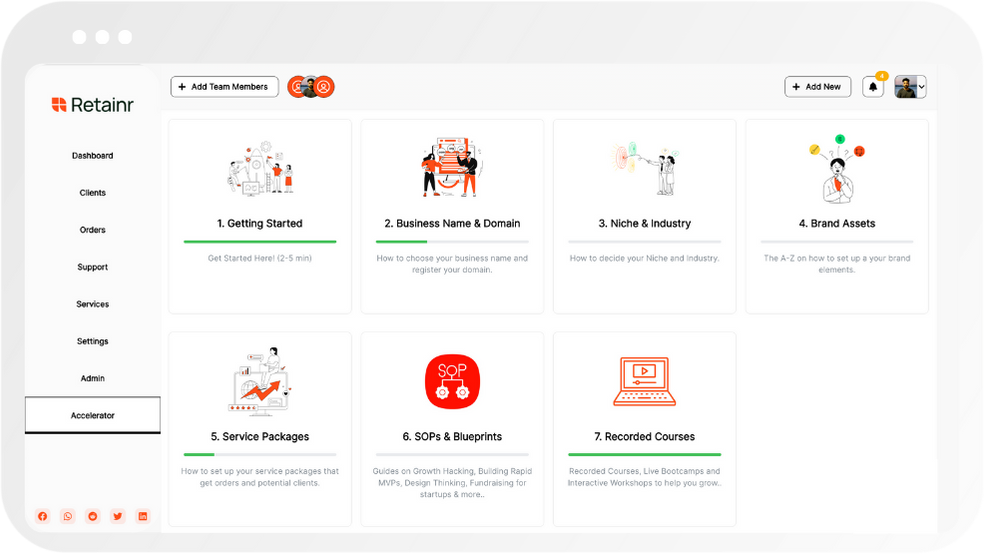
6 Automation Strategies for Small Business
Build with Retainr
Sell your products and services, manage clients, orders, payments, automate your client onboarding and management with your own branded web application.
Get Started1. What are the top 6 automation strategies for small businesses?
Top 6 Automation Strategies for Small Businesses
Adapting to automation is becoming a critical need for small businesses to remain competitive. Automating routine tasks allows companies to focus on strategic initiatives and improve their efficiency. Here are the top 6 automation strategies that small businesses can incorporate into their operations.
- Email Automation: Automation tools can help businesses streamline their email marketing efforts. This includes scheduling emails, tracking open rates, analysing click-through rates, and more.
- Social Media Automation: Posting on social media platforms can be time-consuming. With automation tools, businesses can schedule posts, manage engagements and analyze their performance.
- Finance and Accounting Automation: Simplify financial operations, reduce human error, and save time with finance automation tools. These include invoicing, bookkeeping, and tax preparation tools.
- Sales Automation: Automate tasks like follow-ups, lead scoring, and tracking sales performance to improve efficiency and close deals faster.
- Customer Support Automation: Use tools such as chatbots and automated ticketing systems to provide quick and efficient customer support.
- HR & Payroll Automation: Automate HR tasks, including recruitment, onboarding, and payroll, to save time and improve accuracy.
| Automation Strategy | Benefits |
|---|---|
| Email Automation | Streamlines email marketing, optimizes open rates |
| Social Media Automation | Saves time in scheduling posts, helps analyze performance |
| Finance and Accounting Automation | Saves time, reduces human error, simplifies operations |
| Sales Automation | Improves efficiency, speeds up sales process |
| Customer Support Automation | Provides efficient, swift customer support |
| HR & Payroll Automation | Automates HR processes, improves accuracy |
Implementing these strategies can greatly enhance a small business's productivity, efficiency, and customer experience. Remember that it is essential to choose the right tools for the right tasks to get the maximum benefit out of automation.
2. How can automation strategies improve small business efficiency?
Enhanced Productivity and Efficiency
Automation strategies notably boost productivity and efficiency in small businesses. Firstly, time-consuming routine tasks can be automated, freeing up employees to focus on more complex responsibilities. For instance, bookkeeping software eliminates repetitive manual data entry. Secondly, automation software runs 24/7, ensuring that vital tasks are completed in a timely manner, irrespective of office hours. Thirdly, automation eliminates human errors, ensuring processes are executed accurately, further saving time required for error rectification.
- Automated Tasks: These increase the amount of time employees have to focus on other, more complex duties.
- 24/7 Operation: Business processes continue to run outside of ordinary office hours.
- Error Reduction: Automation reduces the risk of human errors in tasks, leading to increased accuracy and reliability.
Improved Customer Experience
Automation strategies can also enhance the experience of a small business's customers. An automated customer relationship management (CRM) tool provides improved tracking of customer interactions, streamlining communication. Automated email marketing enables businesses to send personalised messages to customers, enhancing customer retention. Furthermore, chatbots provide instant responses to customer queries, increasing customer satisfaction.
- CRM Tools: These manage and analyse customer interactions and data, enhancing customer service and retention.
- Automated Email Marketing: This enables personalised customer communication, improving customer engagement and loyalty.
- Chatbots: These offer immediate responses to customer queries, improving customer satisfaction.
Economical Business Operations
| Automation Strategy | Economical Benefit |
|---|---|
| Inventory Management Systems | Reduces the need for physical inventory checks and prevents overstocking or understocking, saving costs. |
| Payroll Systems | Automates employee payroll, saving time and minimising errors that could lead to financial discrepancies. |
| Automated Invoicing | Streamlines the billing process, getting invoices to customers faster and improving the business's cash flow. |
3. What are the benefits of implementing automation strategies in a small business?
Enhanced Productivity and Efficiency
Implementing automation strategies can significantly improve productivity and efficiency in small businesses. Typically, small businesses may lack the extensive manpower of larger corporations, and as such, their resources must be strategically allocated. Automation can replace repetitive manual tasks, thus freeing up staff to focus on more important areas of the business. Tasks such as scheduling, checklist management, and data entry can all be automated to ensure the critical human resources are employed in strategic decision-making roles, rather than tackling menial tasks.
- Increase in productivity: By automating repetitive tasks, employees can focus on more critical business functions.
- Improved efficiency: Automation reduces the potential for human error, ensuring tasks are carried out accurately and promptly
Cost Savings and Improved Profitability
Automation strategies can also deliver financial benefits. They can decrease overhead costs by reducing the amount of time spent on menial tasks. Additionally, because these tasks are carried out more accurately, they reduce the costs associated with errors. By enhancing productivity, these strategies can also increase profitability, crafting more efficient and effective workflows that directly contribute to the business’s bottom line.
| Aspect | How Automation Helps |
|---|---|
| Cost Savings | Reduces overhead costs by decreasing time spent on menial tasks |
| Error Reduction | Minimizes the costs associated with human errors |
| Increased Profitability | Enhances productivity, leading to improved bottom line |
Improved Customer Experience
Finally, automation strategies can enhance the customer experience, which is vital for businesses of all sizes. Through automating customer service interactions, responses, and follow-ups, businesses can ensure consistent and prompt communication with customers. This leads to improved customer satisfaction and loyalty, driving further growth for the business in the long run.
- Faster response times: Automation enables instant responses, improving the customer's perception of your business.
- Consistent communication: Automated responses ensure consistency in customer experience, building trust and loyalty.
4. Can automation strategies help small businesses save money?
Cost-Saving Aspect of Automation Strategies
Automation technologies undeniably have a significant impact on business expenses. By providing faster and more efficient methods to accomplish routine tasks, these strategies help small businesses save money. Below are some of the ways automation tools can lead to surprising savings:
- Reduced labor costs: Automated systems can perform various tasks more effectively than a human workforce, eliminating the need for numerous employees.
- Improved accuracy: Machines are less prone to errors in comparison to humans, significantly reducing the cost of correcting mistakes.
- Optimized use of time: Automation tools perform tasks quickly, freeing up employees' time to focus on more critical, revenue-generating tasks.
- Minimized overhead expenses: Automation reduces the need for physical resources like paper, leading to lesser overhead costs.
Examples of Cost-Saving Automation Tools
The list below elaborates on some instrumental automation technologies for small businesses, showcasing the potential cost-saving aspect.
| Automation Tool | Description | Potential Savings |
|---|---|---|
| Email Marketing Software | Saves time and effort in sending emails manually to customers by automating the process. | Reduction in marketing human resource costs. |
| Invoicing Software | Generates and sends invoices instantly, eliminating the need for manual preparation and dispatch. | Reduction in administrative costs. |
| Customer Relationship Management (CRM) Systems | Streamlines customer communications, sales tracking, and data analysis. | Improved customer retention, leading to increased sales and revenue. |
Implementing Automation Tools
When appropriately implemented, automation tools can vastly improve your business's bottom line. Introducing technology to your small business should be done gradually, starting with a focus on high-impact areas. The aim should be to free up human resources for higher-value tasks while relegating routine and monotonous tasks to automated systems. This blending of human talent and automation is the key to unlocking significant savings and improving your business's cost efficiency.
5. How can automation strategies help in customer relationship management for small businesses?
The Role of Automation in Customer Relation Management
Automation strategies can significantly enhance customer relationship management (CRM) for small businesses. They enable businesses to streamline operations, improve customer communication, and enhance customer experience. Here, we delve into how automation strategies can assist in CRM for small businesses.
- Timely Communication: Automated emails or messages can be scheduled to reach customers at the right time. This can include welcome emails, reminders for abandoned shopping carts, special discounts, and more. This automation significantly improves customer engagement.
- Customer Segmentation: CRM system can collect and analyze customer data to segment them based on different categories like buying habits, preferences, demographic details, etc. It provides more personalized experiences by generating tailored marketing campaigns for each group.
- Customer Service: Using automation in customer service, such as chatbots or automatic responses, can dramatically improve response time and customer satisfaction. Customers can get immediate answers to their queries without human intervention, which can significantly improve customer experience.
- Sales Cycle Management: Automation can assist in managing the sales cycle more efficiently by maintaining a record of all customer interactions, forecasting sales, and identifying potential opportunities. It can make the entire sales process more streamlined and efficient.
- Feedback Collection: Automation tools can also be used to collect feedback from customers. Evaluating feedbacks systematically and taking necessary action efficiently helps improve product/service quality and enhances overall customer satisfaction.
| Automation Strategy | Role in CRM |
|---|---|
| Email Automation | Send timely, personalized emails to customers |
| Customer Segmentation | Personalize marketing efforts, improve customer engagement |
| Automated Customer Service | Improve response time and customer satisfaction |
| Sales Cycle Management | Streamline sales process, improves efficiency |
| Feedback Collection | Helps improve product/service quality and customer satisfaction |
In conclusion, automation strategies can significantly enhance the CRM of small businesses. Not only do these strategies make CRM more efficient, but they also help in maintaining a more personalized and satisfying relationship with customers.
6. How difficult is it to implement these six automation strategies within a small business?
Implementation Difficulty of Automation Strategies
The level of difficulty in implementing the six automation strategies varies from easy to difficult, depending on multiple factors. These factors include the life stage of the enterprise, the existing infrastructure, funds availability, technical expertise, the current staff's ability to adapt, and the nature of the industry. Despite these challenges, it’s worth mentioning that automation is a potential game-changer for small businesses if correctly implemented. Below we provide a brief difficulty analysis from easy to hard for each strategy.
| Automation Strategy | Difficulty level |
|---|---|
| Email Marketing tools | Easy |
| Social Media Automation | Easy |
| Cloud Computing | Moderate |
| Customer Relationship Management (CRM) Software | Moderate |
| Accounting Software | Hard |
| Artificial Intelligence and Machine Learning | Hard |
Email marketing tools and social media automation are generally straightforward. There are numerous user-friendly platforms that guide businesses through the entire process. The existing skills in the team are usually sufficient to utilize these tools. Cloud computing and CRM software require more resources due to the transfer of information, staff training, and system integration that these solutions typically necessitate. Lastly, accounting software, AI, and machine learning are on the high end of the difficulty spectrum as these technologies may require a solid understanding of the subject and possibly coding skills. Depending on the complexity of the industry, it may also be necessary to hire a specialist.
Although daunting at first, these strategies provide overwhelming benefits in the long run. As time advances, technologies are becoming more user-friendly, and the support available is proliferating. Small businesses need to prioritize and pick what makes the most sense to them at their current stage of growth, gradually integrating more sophisticated automation strategies as the enterprise scales up.
7. Can you provide some examples of small businesses that have successfully implemented these automation strategies?
Successful Small Businesses Automation Examples
In the business cycle, there have been numerous small businesses that have successfully implemented automation strategies. From the retail sector to marketing firms, countless companies have begun taking advantage of the benefits that automation provides. The following are just a few examples:
- 1. MoJo Active: This integrated marketing company has automated its email marketing to help create efficient and effective email marketing campaigns. The automation tool they use assists in customer segmentation, performance tracking, and customer engagement.
- 2. Planet Soho: This small business freelancing platform has automated invoice generation and tracking. It has resulted in timely payments and decreased time combination with fewer errors.
- 3. Saddleback Leather: This retail outfit has executed an automated marketing strategy by employing a centralized customer database to improve the inter-departmental access to critical customer data.
Impressive Benefits Witnessed
These small businesses all witnessed a remarkable transformation upon implementing these automation strategies. The benefits have indeed been numerous, but some of the most significant measurable improvements include:
| Business | Significant Improvement |
|---|---|
| MoJo Active | Increased email marketing effectiveness by over 60% |
| Planet Soho | Improved invoice processing speed by 70% |
| Saddleback Leather | Boosted customer service speed and efficiency by over 40% |
Automation Impact on Business Progress
All these instances make it clear how automation has supplanted traditional methods in many areas of business operations. Gone are the days of labor-intensive and time-consuming processes that were prone to human error. Automation ensures tasks are executed more accurately and efficiently, significantly contributing to increased productivity and profitability. With various automation tools available in the market, small businesses must take advantage of them to enhance their operational efficiency and overall business growth. Indeed, the impact of automation cannot be underestimated as they continue to revolutionize the small business landscape.
8. What are the common challenges small businesses might face during the process of automation?
Identifying the Right Process to Automate
One of the main challenges that small businesses often face during automation is figuring out which process to automate. Although virtually any business process can be automated, not all of them should be. Small businesses often lack the resources and expert guidance, causing them to mistakenly automate processes that are not beneficial in the long run. The right processes to automate are repeatable, are rule-based, involve digital data, and have a high volume.
Resistance to Change
Change, especially technological, can often be met with resistance from employees. People are habitual and thus may view changes as threatening or inconvenient, affecting their productivity. It’s crucial to comprehend and address these concerns. Steps to embrace this challenge can involve:
- Educating employees about the benefits of automation
- Reassuring them about their job security
- Providing necessary training and support
Financial and Technical Constraints
| Constraints | Possible Solutions |
|---|---|
| Financial Limitations | Choosing cost-effective tools, starting with automating small-scale processes. |
| Technical Barriers | Hiring or consulting with IT experts, availing of technical support from the software provider. |
Small businesses typically operate on limited budgets, making it challenging to invest in advanced automation tools. Additionally, they may lack the technical expertise required to implement and manage automated systems. However, cost-effective automation solutions are available, and technical support can be sought from software providers.
9. What are the potential risks of automation to small businesses?
Potential Risk Factors of Automation
Despite the numerous benefits accrued from automation, small businesses also face significant risks. One of the main risks is the high initial cost of implementation. Automation systems and software are expensive and could drain a small business's capital resources. With automation, there is always the potential for job displacement that can lead to disgruntled employees and negative publicity.
- Initial Cost: While automation can save costs in the long run, the initial investment can be quite steep. Implementing new software systems, training staff, and maintaining the new system can all add up.
- Job Displacement: Automation often means less manual work, which in turn could lead to job losses. This could negatively impact staff morale and lead to an unstable working environment.
- Negative Publicity: If not properly managed, automation can lead to negative publicity. This is especially true if job losses occur or if the business fails to properly communicate the reasons behind its decision to automate.
Automation Risk Mitigation Strategies
Though automation presents some risks, small businesses can adopt strategies to mitigate them. Financial risks can be reduced by seeking cost-effective automation solutions and gradually implementing changes. Job displacement can be mitigated by retraining staff and involving them in the automation process. Lastly, maintaining transparency with stakeholders is crucial in managing negative publicity.
| Strategy | |
|---|---|
| Financial Risks | Seek cost-saving solutions, implement changes gradually to prevent overwhelming costs at once. |
| Job Displacement | Retrain employees to handle new tasks, involve them in the automation process to create a sense of ownership. |
| Negative Publicity | Maintain transparency with stakeholders, provide clear communication about reasons and benefits of automation. |
10. How quickly can a small business expect to see returns after implementing automation strategies?
Timeline for Returns on Automation Strategies
Deciding when a small business will begin seeing returns after implementing automation strategies is not a straightforward task. It greatly depends on various factors such as the complexity and extent of the automation, the existing efficiency of the current systems, as well as how readily the employees adapt to the new processes. However, here is a general overview:
- Short-term (3-6 months): Initial results may begin to appear in the form of time savings. Teams should be able to dedicate less time to repetitive tasks, resulting in more time for strategic and creative tasks.
- Mid-term (6 months - 1 year): As adjustments are made and processes are smoothed out, businesses often notice an increase in productivity. At this stage, minor financial gains may begin to occur.
- Long-term (1-2 years): In the long-term, businesses can expect to see significant cost savings and heightened efficiency. This is often when the investment in automation truly begins to pay off.
Factors Affecting Return on Investment (ROI)
The rate at which businesses see returns on their automation investments is influenced by numerous aspects. Below is a table illustrating some key factors:
| Factor | Explanation |
|---|---|
| Type of Automation | Automations for high frequency tasks often tend to present quicker returns as they save more time and resources. |
| Employee Adaptability | The quicker the employees adapt to the new system, the faster the company can reap the benefits. |
| Pre-Automation Efficiency | If previous systems were extremely inefficient, return on investment may be noticeable sooner. |
Ensuring Quick Returns on Automation Investments
To maximize the speed of gaining returns on automation, companies can follow these steps:
- Prioritize high frequency and time-consuming tasks for automation.
- Offer training and support to employees to encourage quick adoption of new systems.
- Analyze existing processes for inefficiencies before introducing automation.
- Implement automation in stages rather than all at once, to allow smoother transition.
Conclusion
Transform Your Business Operations with Automation
Efficiency is key in any small business setup, and this blog outlines six essential strategies to automate operations. Strategies discussed include using email automation to foster customer relationships, implementing project management tools, automating social media marketing, having automated inventory management systems, utilizing software that automates payroll and invoicing, and automating data backup.Supercharge Your Automation with Retainr.io
In addition to these strategies, there is a need for a comprehensive, holistic, white-label software solution. This is where Retainr.io comes in. Designed explicitly for small businesses, Retainr.io provides a streamlined platform to sell, manage clients, orders, and payments with your own branded app.Features and Benefits of Retainr.io
Retainr.io presents a host of features aptly suited for a small business setup. It offers an easy-to-use interface with multiple functionalities aimed at handling client management, order processing, and payment tracking with unparalleled ease and efficiency. Moreover, it enables white-label rebranding, allowing you to customize the software with your own brand identity.By employing Retainr.io, businesses can cut down on time-consuming administrative tasks, improve accuracy, and boost customer satisfaction. Harness the power of automation with Retainr.io and take your small business to greater heights.Boost Your Agency Growth
with Retainr Accelerator
Uncover secrets, strategies, and exclusive blueprints to take your agency's growth to the next level — from marketing insights to effective presentations and leveraging technology.

SOPs, Cheatsheets & Blueprints
Leverage 50+ SOPs (valued over $10K) offering practical guides, scripts, tools, hacks, templates, and cheat sheets to fast-track your startup's growth.
Connect with fellow entrepreneurs, share experiences, and get expert insights within our exclusive Facebook community.
.jpg)

Join a thriving community of growth hackers. Network, collaborate, and learn from like-minded entrepreneurs on a lifelong journey to success.

Gain expertise with recorded Courses, Live Bootcamps and interactive Workshops on topics like growth hacking, copywriting, no-code funnel building, performance marketing and more, taught by seasoned coaches & industry experts.

.jpg)

.jpeg)


